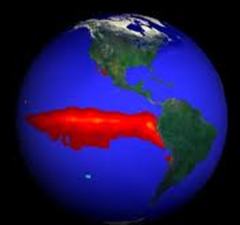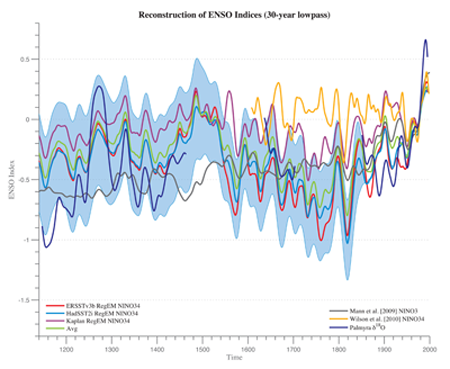Paleoclimate constraints on tropical Pacific dynamics
By:
Julien Emile-Geay
University of Southern California
| When: | Friday, Nov. 04, 2011, 10:30 a.m. to 11:30 a.m. Join us for coffee beginning at 10:00 a.m. |
| Where: | Seminar Conference Room, 10100 Burnet Road, Bldg 196-ROC, Austin, Texas 78758 |
| Host: | Judson Partin, UTIG |


Abstract
Using a compilation of the most recent, high-resolution proxy data from the tropics, and a state-of-the-art climate reconstruction technique (RegEM iTTLS; Emile-Geay et al, submitted), I reconstruct sea-surface temperature (SST) in the central equatorial Pacific (NINO3.4 region) over the past millennium.
Using frozen network experiments and pseudoproxy validation, the reconstruction is found skillful back to 1150 C.E., with inevitable amplitude reduction before 1500 C.E. due to the paucity of proxy predictors. Despite this caveat, wavelet coherency analysis reveals a marked anticorrelation between solar forcing (as estimated from cosmogenic isotope concentrations; Bard et al., 2007; Steinhilber et al., 2009) and the reconstructed NINO3.4 in the ~205-year spectral range (DeVries cycle).
The phase angle between both signals is close to 156 1 33 degrees in this range, indicating that periods of high solar irradiance coincide with cool conditions in the NINO3.4 region, with time lag of 14 1 19 years. We find this result robust to the reconstruction method, estimate of solar forcing, or analysis method used to estimate the phasing.
The reconstruction also exhibits much more vigorous decadal variability than is present in most CMIP3 GCMs. We then discuss the implications of this result for the response of tropical Pacific climate to radiative forcing. While the anti-phasing seems to favor the "ocean dynamical thermostat" hypothesis of Clement et al. [1996], this feedback appears subdued in most IPCC-class coupled general circulation models (CGCMs), where it is almost completely compensated by changes in the Pacific trade winds, linked to changes in the vertical structures of atmospheric moisture and temperature (Knutson & Manabe 1995; Held & Soden 2006; Vecchi et al. 2006).
If the reconstructions are correct about the antiphased response to solar forcing and the high amplitude of decadal variability, this would pose a new challenge to both for CGCMs and to our understanding of forced and unforced low-frequency variability in the tropical Pacific.




